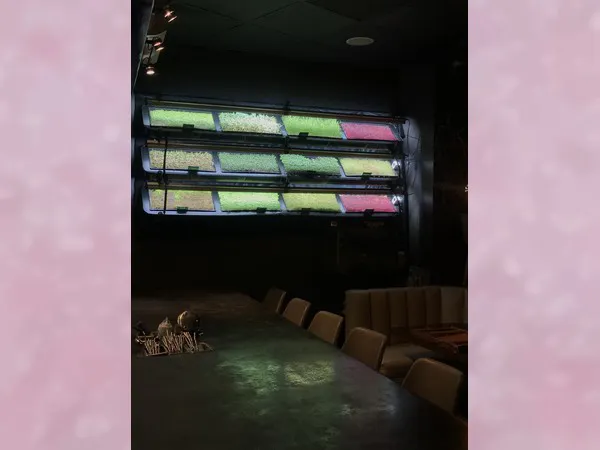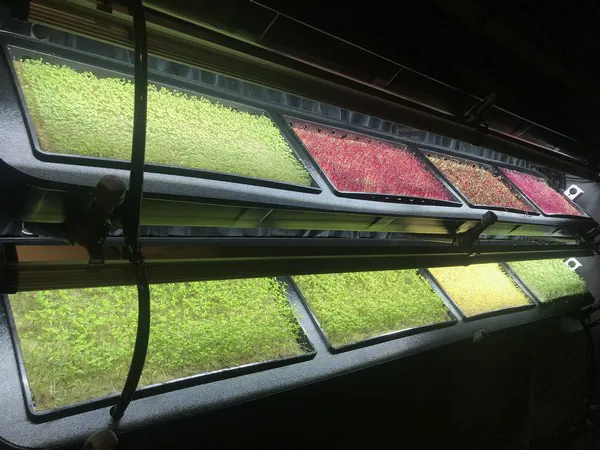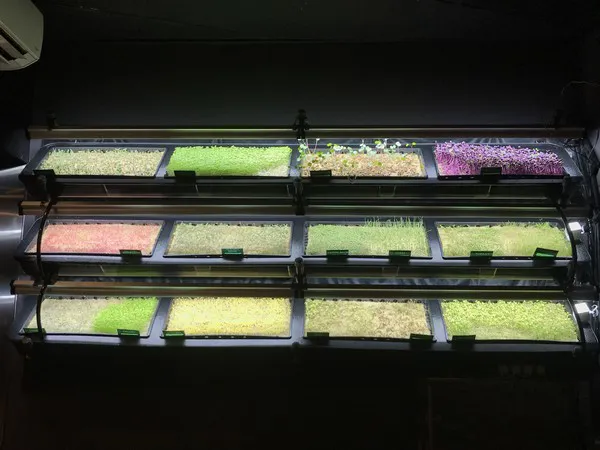Picture the scene. You're in a restaurant, a delicious plate of food is sitting before you on the table. Then the chef shows up. "Just one minute, please", he says, walking over to the wall and harvesting some fresh microgreens from it. He sprinkles the finishing touch onto the dish. "Voilà!"
If it sounds like fiction, think again, because in several restaurants across the U.S., this scene may well occur, thanks to the in-restaurant cultivation systems from inHouse Produce. One of the restaurants that uses the cultivation racks is Scratch Bar & Kitchen in Los Angeles.
"At Scratch|Bar, we have always prided ourselves on being as 'from Scratch' as possible, making our own butter, vinegar, bread and even charcuterie," says Gavin Humes, executive chef at the restaurant. "Working with inHouse Produce was a way for us to get even the production of microgreens inhouse. It also gave us the ability to work on growing specific microgreens that were not always available from our traditional suppliers, which has been fantastic."

Local cultivation, remote management
So, how do these indoor cultivation systems work? Andrew Blume, co-founder of inHouse Produce, explains that most of the functionality on the gardens is automated. Farm technicians are tasked with the once-monthly deep sanitation of the system, which currently takes a team of two approximately one hour. "We have some design improvements coming up that should reduce the labor requirement", Andrew says.
To get started with the system, restaurant owners need "just 28” of wall space and a dream to grow their own produce", as Andrew puts it. "A big advantage of the service model is that the farm technician can also be the account manager and delivery person. When they do the clean, they replenish supplies and speak with the client about how the garden is performing. This is a great time to get feedback and to make micro-adjustments that will improve our offering."
In addition to the monthly visits, each farm has multiple cameras that take images at regular intervals. These images are uploaded into a database and inform computer vision and machine learning algorithms. "Soon we will be rolling out automated text message reminders to the restaurant staff for when to do basic tasks like moving trays or harvesting."
It sounds straightforward, and according to Gavin, it is. "It's pretty simple. We trained one of our cooks, and of course management to be familiar with it, and the team at inHouse Produce has always been very helpful in resolving any issues that we do have."

Microgreens à la carte
The inHouse Produce gardens are capable of growing over 100 different microgreen varieties. "During the sales process, we meet with the chef to hone in on what crops will be great for their menu. This is our favorite part of the job because we love the creativity of our chef partners; food will always benefit from a strong chef-farmer relationship", Andrew says.
Gavin agrees that getting to pick and choose what microgreens to grow is one of the main advantages of the system. "Really there are two main advantages. First, it allows us to have more control over the microgreens that we work with. If we order from a vendor, they come in whatever size they come in, and in the varieties they choose to grow. With inHouse Produce, we're able to customize our offerings, and also harvest them when they're precisely the size and maturity level that we prefer. Second, it provides a focal point in the dining room that starts lots of conversations and gets people excited about what we have."

Spicing up the dining experience
Gavin goes on to say that at Scratch, they already frequently used microgreens before. "We still use them now, but since they're of a wider range of styles and varietals, we're able to use them in more creative and interesting ways, as opposed to solely as garnish to look nice. They're able to be more integral to the dish."
Asked about his favorite dish that incorporates the greens from the inHouse Produce system, Gavin says: "Probably the most interesting is our leek dish. Specifically we take a full grown leek, slice it into medallions, and sear it hard in a pan. Then we punch the center our of the leek, slice the interiors and cream them. We fold those creamed leeks back into the 'shell' of the leek, top it with a mustard made in house from leeks, and then top the whole thing with crispy leeks to give it texture. We incorporate the philosophy of 'root to stem' cooking with leeks in using the inHouse Produce system to produce microleeks to garnish the dish. So it's leeks, stuffed with leeks, topped with leeks and garnished with microleeks."
And the effect of the inHouse Produce gardens goes beyond the plate. According to Gavin, responses from patrons have been overwhelmingly positive. "Guests have commented frequently on how unique and cool the system looks, and we are regularly asked questions about how it works, and what uses we get out of it. When we're not too busy we encourage our guests to even go over to the system so they can get an up close look at it, and how we use all the cool products we can grow!"
For more information: inHouse Produce
inHouse Produce
310-853-0617
info@inhouseproduce.com
inhouseproduce.com
